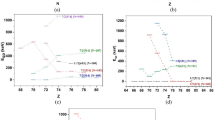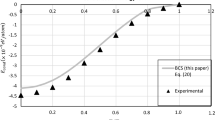Abstract
The possible instabilities of a 1-dimensional itinerant electron gas are discussed, assuming electron-electron interaction to play the dominant role. As is well known, in the RPA, a 1-dimensional metal is prone to spin density wave (SDW), charge density wave (CDW) and Cooper pair (CP) instabilities. The spin channel decomposition of the irreducible scattering amplitude I is made and the spin channel projections are evaluated in terms of the matrix elements of bare electron-electron interactionV(x) for momenta of interest. It is found that if the bare electron interactionV(x) is repulsive and decreases monotonically with separation, only the SDW instability will occur. If the small separation (x≳(2k F )−1) part of the interaction is greatly reduced or is made attractive,V(x) is non-monotonic,V q (q≅2k F ) is negative, and a CDW instability is preferred. A CP instability is possible if the electron interaction is attractive,i.e., if [V q (0<q<k F )+V q (q⋍2k F )]<0.
The above RPA results serve only as rough indicators, since in general there are important two-electron configurations with two-electron momentum close to zero and with electron hole momentum close to 2k F , an example being the near Fermi energy configurationk 1⋍k F ,k 2⋍−k F ,k 3⋍−k F k 4⋍k F . Therefore as pointed out first by Bychkov, Gorkov and Dzhyaloshinskii (BGD), cross channel coupling is especially significant. It is shown that the cross channel coupling is constructive is some cases,eg., exchange of CD fluctuations leads to an effective electron-electron spin singlet attraction and vice-versa. A formalism for studying such effects is set up, and the particular example mentioned above is discussed. An RPA-like approximation is made for the form of the reducible singlet electron hole scattering amplitudeγ ds and the resulting induced Cooper pair attraction is calculated to be
where λ=1.14,β=(k B T)−1 andω 0 is an electronic energy cut-off ∼ε F . The induced electron hole attraction due to the exchange of virtual Cooper pairs has a similar expression, but with a factor of (1/4) and withγ e s (q=0) replacingγ d s (q=2k F ). The induced Cooper pair attraction is seen to be quite large over a broad range of temperatures close to but aboveT CDW [i.e., aboveT such thatγ d s (q=2k F )−1=0]. There is no requirement thatγ d s (q=2k F ) andγ e s (q=0) become singular at the same temperature, as found by BGD. The BGD prediction is seen to arise from the neglect of real particle hole and particle-particle excitations while calculatingγ d s andγ e s . The effect of impurities, of electron-phonon coupling, of interchain coupling and of interaction between thermal order parameter fluctuations is discussed. The results are then applied to a discussion of the properties of TTF-TCNQ, where it is suggested that a CDW instability occurs becauseV q (q=2k F )<0,i.e., because the small separation electron repulsion is strongly reduced by the highly polarizable TTF. Because of substantial interchain coupling, the bulk CDW instability occurs close to the RPA instability temperature. The giant conductivity observed by Colemanet al is attributed to superconductive fluctuations in a 1-dimensional system with large mean field superconductive transition temperatureT MFCP of order 300°K. Such a largeT MFCP is shown to result from the induced Cooper pair attraction due to CD fluctuation exchange.
Similar content being viewed by others
References
Abrikosov A Aet al. 1963Quantum Field Theory Methods in Statistical Physics (Prentice Hall Englewood Cliffs).
Abrikosov A A 1965Physics (N.Y.) 2 39
Abrikosov A A and Migdal A A 1970J. Low Temp. Phys. 3 519
Allender D, Bray J W and Bardeen J 1974Phys. Rev. B. (to be published)
Amit D J, Kane J W and Wagner H 1968Phys. Rev. 175 313
Anderson P W, Lee P A and Saitoh M 1973Solid State Commun. 13 595
Aslamazov L G and Larkin A I 1968Fiz. Tverd. Tela. 10 1104 Soviet Physics Solid State10 875
Bardeen J 1973Solid State Commun. 12 1125
Berk N F and Schrieffer J R 1966Phys. Rev. Lett. 17 433
Brinkman W F and Anderson P W 1974Phys. Rev. Lett. 30 1108
Brout R H 1965Phase transitions (New York. Benjamin)
Bychkov Y A, Gorkov L P and Dzhyaloshinskii I E 1966Soviet Phys. JETP 23 489
Chaikin P M and Heeger A J 1973Phys. Rev. Lett. 31 601
Coleman L Bet al. 1973Solid State Commun. 12 1125
Comes R, Lambert M and Zeller H R 1973Phys. Status Solidi. 58 587
Dzhyaloshinskii I E and Larkin A I 1972Soviet Phys. JETP 23 489
Epstein A J, Etemad S, Garito A F and Heeger A J 1972Phys. Rev. B5 952.
Ferraris J, Cowan D, Walatka V Jr., Perlstein J H 1973J. Am. Chem. Soc. 95 948
Fowler M and Zawadowski A 1971Solid State Commun. 9 474
Fröhlich M 1954Proc. Roy. Soc. (London), Ser A 223 296
Garito A F and Heeger A J 1974Collective Properties of Physical Systems eds. S Lundqvist and B I Lundqvist (Oxford: Pergamon press)
Hassing R F and Wilkins J W 1973Phys. Rev. B7 1890
Hohenberg P 1967Phys. Rev. 158 383
Hone D W and Pincus P 1973Phys Rev. B7 4889
Kuper C G 1955Proc. Roy. Soc. (London) Ser. A 227 214
Langer J S and Ambegaokar V 1967Phys. Rev. 164 498
Lee P A, Rice T M and Anderson P W 1973Phys. Rev. Lett. 31 462
Lee P A, Rice T M and Anderson P W 1974Solid State Commun. 14 703
Lee P A 1975Phys. Rev. Lett. 34 1427
Little W A 1964Phys. Rev. 143 A 1416
Luther A and Peschel I 1974 aPhys. Rev. B9 2911
Luther A and Peschel I 1974 bPhys. Rev. Lett. 32 992
Luther A and Emery V J 1974Phys. Rev. Lett. 33 589
Luttinger J M 1963J. Math. Phys. 4 1154
Menyhard N and Śolyom J 1973J. Low Temp. Phys. 12 529
Noziéres P 1965Theory of Interacting Fermi Systems (New York: Benjamin)
Overhinnikovet al. 1973Sov. Phys. Usp. 15 575
Overhauser A W 1960Phys. Rev. Lett. 4 462
Patton B R and Sham L J 1973Phys. Rev. Lett. 31 631
Peierls R E 1953Quantum Theory of Solids (Oxford University Press)
Pincus Pet al. 1973Solid State Commun. 12 1265
Renker Ret al. 1973Phys. Rev. Lett. 30 1144
Rice T M 1965Phys. Rev. 140 A1889
Rice T M 1967J. Math. Phys. 8 158
Roulet P, Gavoret J and Noziéres P 1969Phys. Rev. 178 1072
Strässler S and Toombs G A 1974Phys. Lett. 46 A 321
Suhl H 1965 aPhysics (N.Y.) 2 39
Suhl H 1965 bPhys. Rev. 128 A 515 (1965)
Suhl H 1973Magnetism vol. 5 (New York, Academic Press)
Tomonaga S I 1950Prog. Theor. Phys. (Kyoto) 5 544
Tucker J R and Halperin B I 1971Phys. Rev. 3B 3768
Vegter J G, Kommandeur J and Fedders P A 1973Phys. Rev. 7B 2929
Weiner R A 1971Phys. Rev. 4B 3165
Werthamer N R 1969 inSuperconductivity ed. R D Parks Vol. I p. 336 (New York, Marcel Dekker)
Zawadowski A 1974 inCollective Properties of Physical Systems ed. B I Lundqvist and S Lundqvist p 76 (Oxford, Pergamon Press)
Zeller H R 1973, inFestkorperprobleme Vol. 13, ed. M J Queisser (New York, Pergamon Press)
Author information
Authors and Affiliations
Rights and permissions
About this article
Cite this article
Ramakrishnan, T.V. Electron-electron interaction and instabilities in one-dimensional metals. Pramana - J. Phys. 7, 63–94 (1976). https://doi.org/10.1007/BF02875317
Received:
Revised:
Issue Date:
DOI: https://doi.org/10.1007/BF02875317




